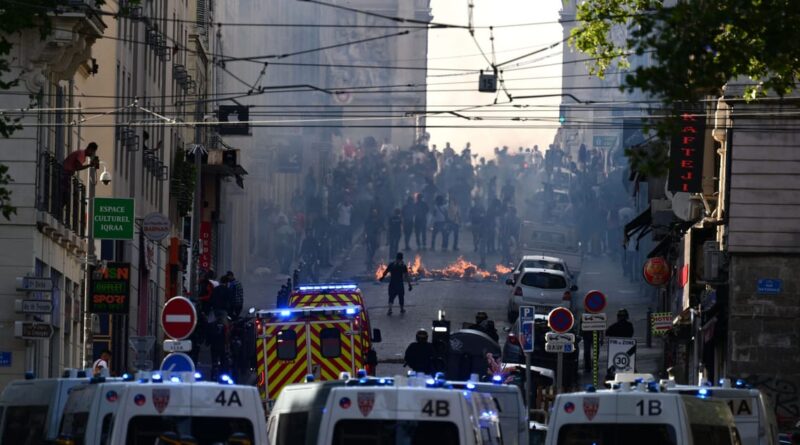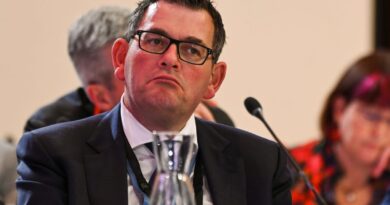As France burns, Macron blames social media for fanning the flames
PARIS — French rioters have set the country on fire and Emmanuel Macron is pointing the finger at TikTok and Snapchat for pouring gasoline on the inferno.
In the past three days, violent protests erupted across France after a police officer in a Paris suburb shot and killed 17-year-old Nahel M., who was of North African descent. Rioters targeted public buildings, transport systems and shops with projectiles and Molotov cocktails, leaving 249 members of law enforcement injured and 875 people arrested.
Unlike the deadly outbreak of violence in 2005, the turmoil — which has led to public transportation shutdowns, concert cancelations and armored vehicles being deployed across the country — can be documented in real time, shared online and seen by tens of thousands on social media platforms such as TikTok, Snapchat and Twitter.
That online phenomenon is worrying France’s political leaders, who have been scurrying to find solutions as the unrest shows no sign of fizzling out.
“We’ve seen violent gatherings organized on several [social media platforms] — but also a kind of mimicry of violence,” French President Emmanuel Macron said Friday after a government crisis meeting. He accused younger rioters of exiting reality and “living the video games that have intoxicated them.”
The French president wants tech companies to delete violent content and provide law enforcement with the identity of protesters who use social media to stoke — and exacerbate — the disorder. “I expect these platforms to be responsible,” he said.
According to research by France’s most-watched news channel BFM, TikTok and Snapchat were flooded Friday morning with videos from the rioting and looting across France. On TikTok, hashtags linked to the riots were pushed by the platform’s algorithm. Police officials also told BFM some protesters coordinate and communicate in real time through messaging services on WhatsApp and Telegram via online tools that did not exist in 2005, when riots left hundreds of public buildings damaged and thousands of cars burned.
The government is scheduled to meet with social media platforms Friday evening, where company executives will be pressed to cooperate.
Some, however, say social media platforms are unfairly blamed by grandstanding politicians who should focus their attention elsewhere.
On Friday, the U.N.’s human rights office weighed in, saying France needs to address “issues of racism and discrimination in law enforcement,” referring to the killing of the teenager.
Tech has long been used to coordinate demonstrations and protests, political communications expert Philippe Moreau Chevrolet told POLITICO, adding that the government would be “terribly out of touch” to respond to the crisis by focusing on tech companies and video games.
“Text messages used to be accused [of facilitating riots], now it’s social networks. Yellow Vests protests were blamed on Facebook,” Moreau Chevrolet said.
Two sides of the coin
But the role of online platforms goes beyond showcasing fires and looting, and helping rioters get organized. This week’s violent unrest began with a video that was, of course, posted on social media.
“There’s clearly been a change, with more and more people adopting the reflex of filming the police. Above all, the activists’ community is now able to quickly and widely circulate the videos,” said Magda Boutros, a sociology scholar at the University of Washington who studied activism against police violence in France.
When a police officer shot and killed Nahel M. (the name by which he has been identified publicly) on Tuesday, media reports originally relied on law enforcement sources claiming a driver threatened the police officer’s life. But a video, filmed by a bystander and posted on Twitter, showed a different story: Two cops stood next to a car and one shot the driver at close range.
Another recent incident (crucially, not filmed) showed the power of social media to hold violent police officers accountable and the ability to set a country on fire — or not.
Two weeks ago, a teenager died in similar circumstances as Nahel M. in the Charente region of western France. The young man was reportedly shot dead by a police officer for refusing to comply.
That went relatively unnoticed, explained former French MP Thomas Mesnier, because Charente is in a more remote area compared to the dense banlieues of the French capital.
It also went unnoticed, Mesnier said, because “there was no video that went viral on social networks, participating in and reinforcing people’s emotions and sense of dread.”
Elisa Bertholomey contributed reporting.




